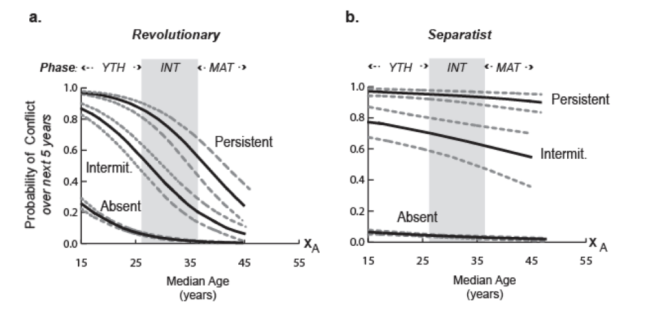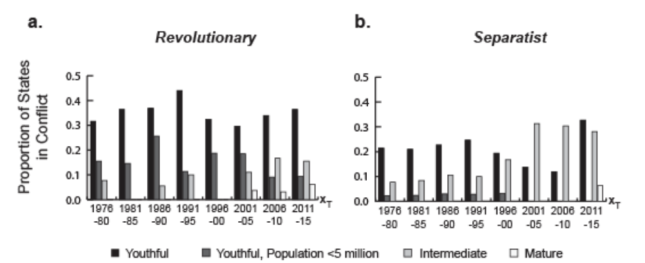-
Separatist Conflicts Persist, While Revolutions Just “Age Away”
September 18, 2018 By Richard Cincotta
The research presented in this article was subsequently published in a peer-reviewed article: https://link.springer.com/chapter/10.1007/978-3-030-73065-9_3
The Kurdish people’s century-long quest for self-determination reveals a key aspect of ethnic separatist conflicts. Ideas of nationhood can endure for generations, unifying people across borders and often making separatist conflicts hard to resolve. But how much harder is it to resolve separatist conflicts than other violent, non-territorial intra-state wars (such as political revolutions)? In practical terms, how much longer, on average, can policymakers expect separatist conflicts to persist and reoccur than the typical political revolution? These are tough questions. Surprisingly, demography helps us find the answers.
Since the seminal research of Herbert Möller in the late 1960s and Jack Goldstone in the early 1990s, numerous political researchers have called attention to the tendency of countries with youthful populations—often called a “youth bulge”—to be more vulnerable to civil conflict than nearby states with a more mature population. Then a 2016 article upset political demography’s apple cart. When investigating countries with at least three consecutive years without an intra-state conflict, Omar Yair and Dan Miodownik found a fundamental difference between ethnic and non-ethnic warfare. The risk of a non-ethnic conflict was, indeed, higher under youth-bulge conditions. However, they found that youth bulges (measured at the country level, rather than at the ethnic level) were unrelated to the risk of an onset of an ethnic conflict.
La Différence Vit?
In research for a soon-to-be-published article, I set out to investigate a bit beyond Yair and Miodownik’s conclusions, asking two new questions:
- Do the differences that Yair and Miodownik observed extend to countries with a history of recent of conflict?
- How do these effects play out over the course of the age-structural transition—as populations age, shifting from a youthful population with a low median age, to a more mature population with a high median age?
To address these questions, I added three variables measuring the country’s history of conflict (number of years within which a conflict occurred):
- Conflict absence, representing countries with no conflict years during the past four years;
- Intermittent conflict, for countries with one or two conflict years during that four-year period; and,
- Persistent conflict, for countries with three or four conflict years during that period.
I plotted the risk trends for these three conflict history types against the country’s median age, which tracks the journey of countries through the age-structural transition (see Figure 1a & 1b). As a guide to this transition, the National Intelligence Council’s (NIC’s) age-structural phases are shown on the graphs. These phases are:
- Youthful phase (YTH), a median age of 25 years or less;
- Intermediate phase (INT), 26 to 35 years; and,
- Mature phase (MAT), 36 to 45 years.
Rather than return to the data that Yair and Miodownik employed, I drew conflict data from the UCDP/PRIO Armed Conflict Data Set—a well-maintained source that differentiates territorial conflicts (which generally involve ethnic separatists) from intra-state conflicts, where the opposition aims to overthrow the central regime or the entire political system (i.e., revolutions).
My research produced several major conclusions:- To predict separatist conflicts, measures of country-level age structure are not useful risk indicators. Despite a slightly higher risk borne by countries with youthful populations (Fig. 1b), separatist (territorial) conflicts are largely insensitive to changes in country-level measures of age structure. In fact, separatist conflicts have recurred throughout the age-structural transition, particularly when the separatist minority remains youthful, or when they receive assistance from outside the country.
- To predict revolutionary conflicts, measures of country-level age structure are useful Regardless of their recent conflict history, youthful countries have been more prone to revolutionary conflict than countries with a more mature population. Countries that have reached the intermediate phase of the age-structural transition are much less likely to experience a revolutionary conflict (Fig. 1a).
- A recent intra-state conflict dramatically amplifies the risk of recurrence. While the future risk of continued revolutionary conflict dramatically declines as population ages, the risk of a future separatist conflict is barely affected by aging (Fig. 1b).
- When conflict has been absent for four years, the risk is typically low—except among very youthful countries, which face elevated risks of revolutionary conflict. Youthful countries with populations under five million also face an elevated risk of revolution, but not as high as their more populous neighbors.
Youth Bulge Theory Isn’t What It Was
These findings are likely to alter the direction of demographic research on intra-state conflict. To determine if demography can help us anticipate separatist (territorial) conflicts, political demographers will need to pursue sub-national data that uncover demographic differences between ethnic groups—gaps that expose deep cultural, economic, and political fissures that could be used to mobilize an ethnic insurgency or whip up anti-minority violence.
These findings also open opportunities to explore a stronger youth-bulge model focused only on revolutionary conflicts. As before, youthful countries—particularly those with a population over five million—remain the most likely candidates for new revolutionary conflicts. However, this research also suggests that we can use age structure to anticipate when revolutions will weaken—and, ultimately, end—as well as assess the country’s prospects of achieving political stability.
Research on separatist conflict and on revolutions are due to go their separate ways. The products of these distinct efforts could, in the future, help defense planners and peacebuilders better understand their chances of achieving peace—or help them plan for the eventuality of protracted warfare.
Richard Cincotta is a global fellow at the Wilson Center and non-resident fellow at the Stimson Center.Sources: Asia Times, Conflict Management and Peace Science, Peace Research Institute Oslo, Political Demography
Photo Credit: Protesters, youths and CSF forces face off on the south side of Tahrir Square, December 2011, courtesy of Alisdare Hickson.
Topics: aging, conflict, demography, development, featured, Guest Contributor, population, research, security, youth
 A Publication of the Stimson Center.
A Publication of the Stimson Center.









